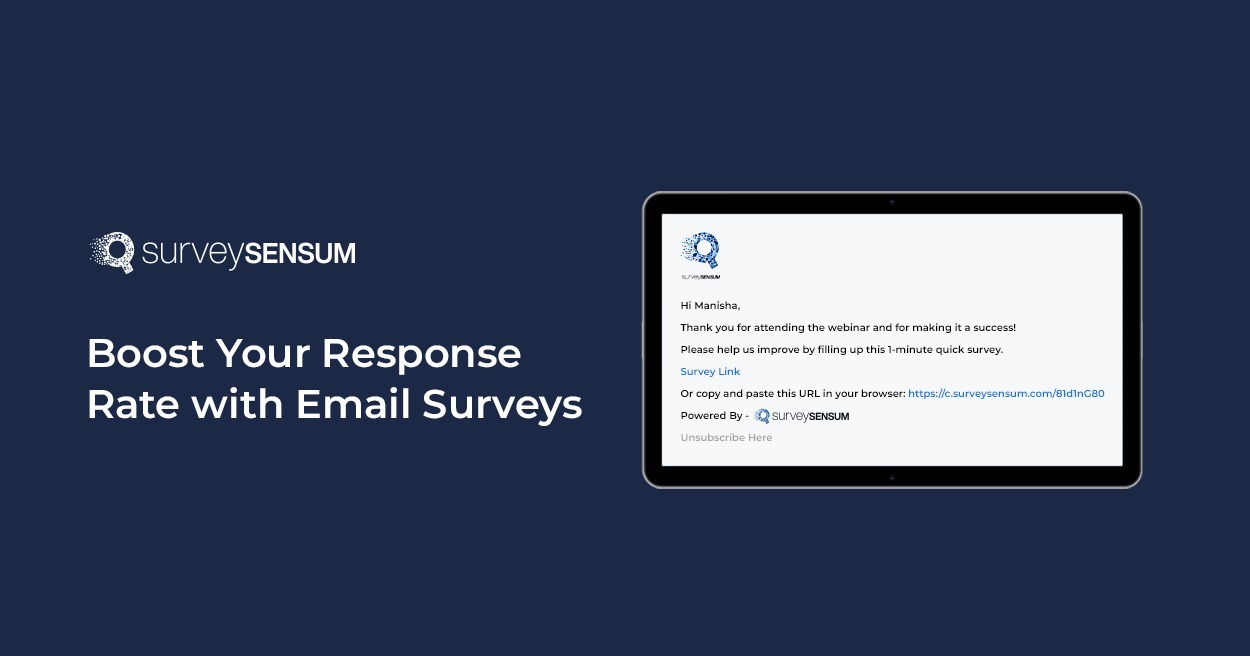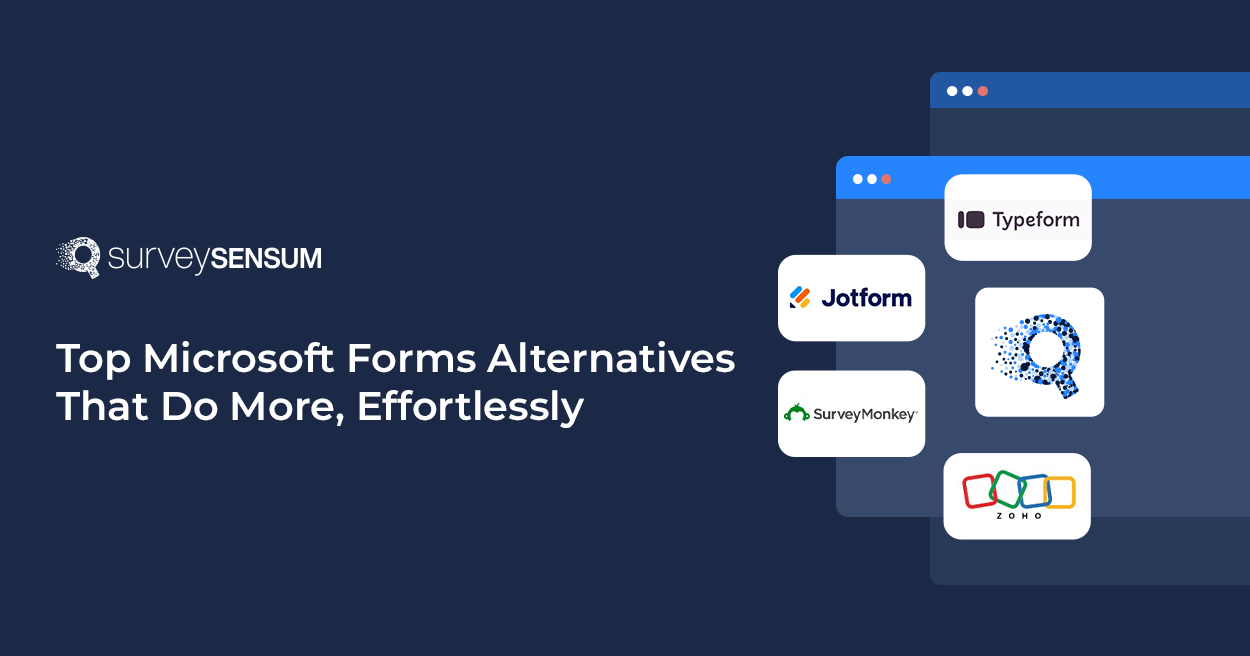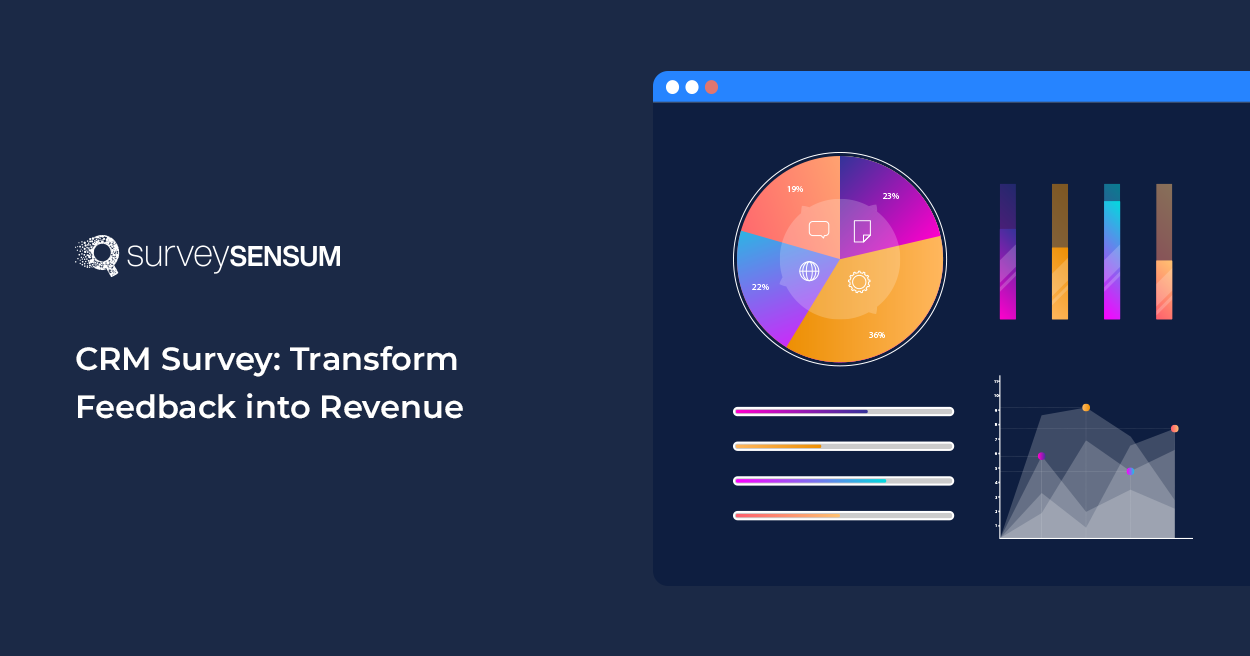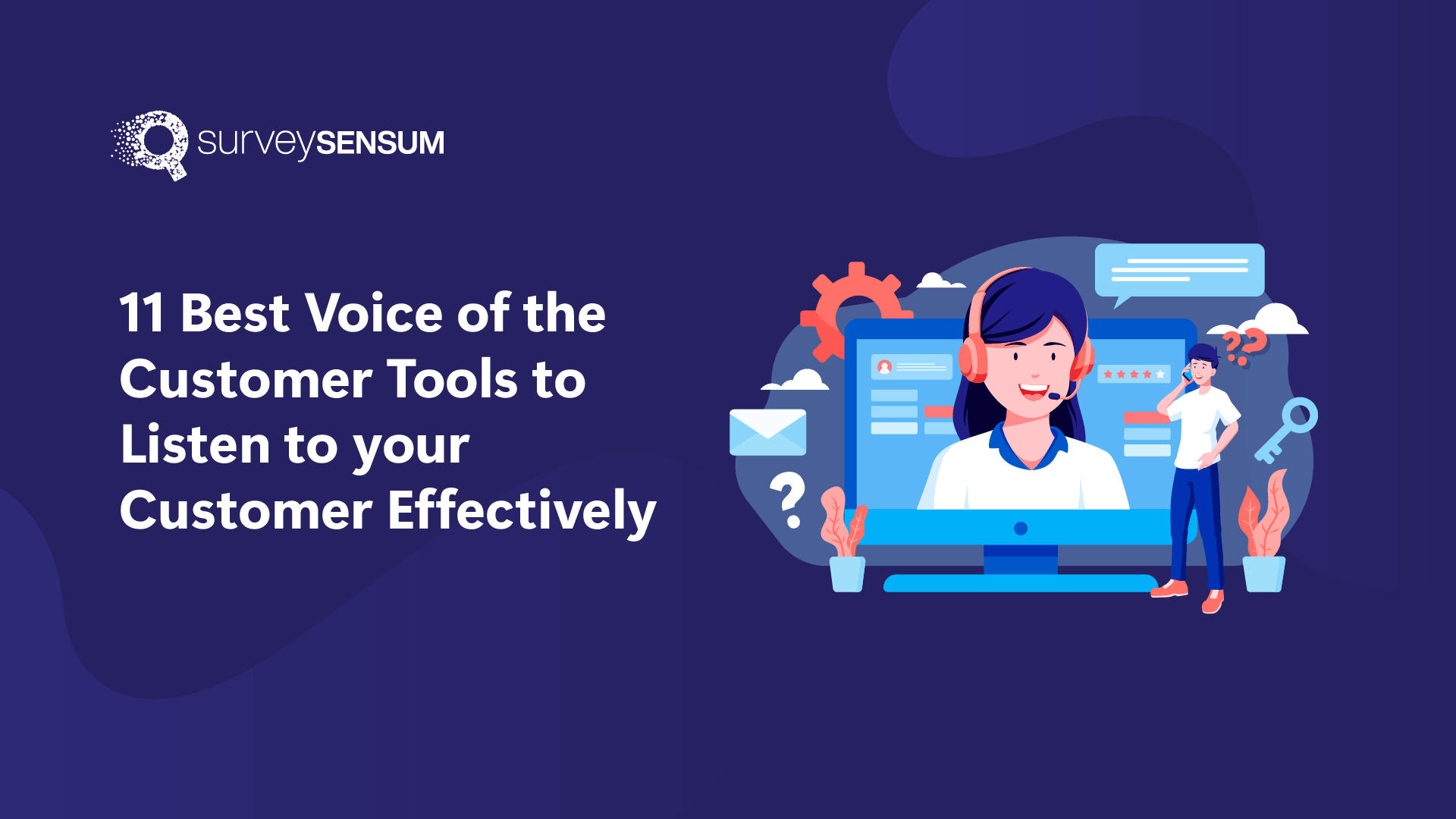
Who better to tell you what you are doing right or where you need to improve than your own customers? Now, one of the effective ways to stay connected with your customers and gather valuable feedback is through email surveys.
Yes, email surveys – they still work great. In fact, 87% of marketers believe that email marketing is very crucial to a business’s success. It is the best course of action when it comes to gathering customer feedback, but only when it’s done correctly.
Scroll down to understand how email surveys work, their types, and how it is beneficial to your marketing strategy.
What are Email Surveys?

Email surveys are a method of collecting feedback from your customers or target audience via emails. These surveys involve sending a set of questionnaires via email which the respondents can either answer in the email itself or go to a survey website through the URL provided in the email.
The beauty of email surveys lies in their versatility and efficiency. They allow businesses to:
- Engage with a large number of customers at the same time.
- Customize questions to match the specific needs and objectives of the audience.
- Engage with customers in a non-intrusive manner.
Want to create email surveys but don’t know where to start? Well, start by signing up to SurveySensum today to create, launch, and analyze your email surveys all in just under 10 minutes!
But why send an email survey?
Advantages of Using Email Surveys
Here are some of the reasons why you should incorporate email surveys in your survey campaigns.
1. It Is Cost Effective: Unlike traditional survey methods like face-to-face surveys, telephone surveys, etc, email surveys are cost-effective as there is no need for additional tools or software or any type of printing materials to launch this survey. All you need is your trusted survey builder tool and the email IDs of your customers. A robust tool will also help you launch the surveys in the same place without the need to switch between different tools.
2. It Reaches a Wider Audience: Whether you want to survey a local audience or want to connect with international customers from all around the globe, with email surveys you can connect with whichever audience you want whenever you want. You don’t have to worry about tariff charges, and don’t have to upgrade to international packs like in telephone and SMS surveys. A proper DKIM record generator helps authenticate your email, ensuring better deliverability and reducing the likelihood of your surveys being marked as spam.
3. It Allows Personalization: Email surveys can easily be tailored to a specific audience, making them more engaging and relevant. In fact, 72% of customers only want to engage with brands that provide personalized messaging. Personalized surveys that address the respondent by their name or reference their recent transaction can definitely lead to a higher response rate.
4. It Is Scalable: Whether you want to survey a small group of customers or a large one, email surveys can be easily scalable. You can easily adjust the number of recipients without increasing the effort or cost on your part.
Now that you know what and why to use email surveys, the next question is which types of email surveys to use and when.
Types of Email Surveys (With Examples)
Here are the different types of email surveys and when to use them.
1. Customer Satisfaction Surveys

Understanding your customer’s satisfaction level with your product, service or overall brand will help you gain insights into your customer’s experience, expectations, and needs. This will help you create better and more positive experiences for them. Now, when it comes to gauging customer satisfaction levels, there are a few metrics to track including,
- NPS: This helps you gain insight into customer loyalty and the likelihood of word-of-mouth promotion. You can launch this survey after the customer has had time to get acquainted with your product or service.
- CSAT: This helps in understanding customer satisfaction with any product, service, or overall experience. You can launch this survey post-transaction, post-delivery, order, or event.
- CES: This helps you measure the amount of effort taken on the customer’s part to engage with your product, service, or overall brand. You can launch this survey immediately after the transaction or call is over.
Questions to ask
- On a scale of 0-10, how likely are you to recommend our company/product/service to a friend or colleague? (Rating Scale)
- On a scale of 1-5, how would you rate the quality of our product/service? (Rating Scale)
- On a scale of 1-7, how much effort did you personally have to put forth to handle your request? (Rating Scale)
Launch all types of customer satisfaction surveys – NPS, CSAT, CES, with SruevySensum’s robust surveys builder.
2. Product Feedback Surveys

Gathering product feedback will help you gain insights into some crucial aspects like whether your product meets your customer’s expectations, which areas are performing well and which are not, and whether the update met your customer’s expectations.
- New Product Launch: This survey will help you understand how well the new product met your customer’s expectations. You can launch this survey after the launch of a new product to gather feedback on initial impressions, usability, and overall satisfaction.
- New Feature Update: This survey will help you determine whether or not the new feature update met your customer’s expectations. You can launch it after the new feature update.
- Overall satisfaction: Along with understanding product and feature update satisfaction, you also need to understand the overall satisfaction of your customers with your product. This will help you identify issues, understand customer expectations, and overall product performance, guiding you in making necessary changes.
Questions to ask
- On a scale of 1-10, how would you rate your initial impression of our new product? (Rating Scale)
- Did our new feature update meet your expectations? (Yes/No)
- Have you experienced any issues with our product? If so, please describe them. (Open-ended)
3. Post-Transaction Surveys

Understanding customer experience and satisfaction post-transaction will help you gain insights and improve your post-transaction touchpoints like delivery services, customer support, etc.
- Post-Purchase: Sent shortly after purchase to gather feedback on the buying experience, product satisfaction, and any issues encountered. This helps in ensuring a smooth purchase process and high product quality.
- Abandoned Cart: These surveys aim to understand why customers did not complete their purchases. Insights from these surveys can help improve the checkout process and reduce cart abandonment rates.
Questions to ask
- On a scale of 1-5, how satisfied are you with your recent purchase? (Rating scale)
- What was the primary reason you did not complete your purchase?
- Was there anything about the purchasing process that could be improved?
4. Market Research Surveys

Understanding your market helps you evaluate your competitors, and market conditions, and gain insight into customers’ behavior and expectations.
- Consumer Behavior: This survey is launched to gather data on customer preferences, purchasing habits, and demographic information. This helps in understanding your target market better and tailoring your offerings accordingly.
- Competitor Analysis: These surveys collect information about customers’ experiences with competitors. Insights gained from these surveys can help you identify your strengths and areas where you can outshine the competition.
Questions to ask
- What factors influence your decision to buy a product/service? (Open-ended)
- Can you describe your typical buying process? (Open-ended)
5. Customer Service Surveys

Did you know that for 86% of customers, good customer service can turn one-time clients into long-term loyal customers?
Understanding how your customer service process is working will help you improve and streamline your customer service process and its different touchpoints to improve your customer experience and reduce customer effort.
You can launch this survey right after the customer has interacted with your customer support team. You can ask them if their issue was resolved, whether or not they were helpful and knowledgeable in resolving the issue, and their overall satisfaction with the service.
Questions to ask
- On a scale of 1-7, how would you rate the quality of the service you received? (Rating scale)
- Was your issue resolved to your satisfaction? (Yes/No)
- What could we do to improve your support experience? (Open-ended)
6. Industry-Based Surveys
- Healthcare Surveys: Email surveys can be launched in the healthcare industry to gather patients on their experience with healthcare services, including quality of care and interaction with medical staff.
- Employee Satisfaction Surveys: These surveys measure how satisfied employees are with their workplace, management, and job roles. They help identify areas for improvement to enhance employee morale and retention.
- Event Surveys: These surveys are sent after an event to gather attendees’ feedback on various aspects such as content, organization, and overall experience. This feedback is crucial for improving future events.
- Non-Profit Feedback Surveys: Collect feedback from donors on their donation experience and what motivates their support. This helps in enhancing donor engagement and retention. For collecting feedback, you can use an all-in-one event platform for everything from promoting to efficient ticketing for nonprofit events.
Questions to ask
- On a scale of 0-10, how likely are you to recommend our healthcare services to family and colleagues? (NPS)
- On a scale of 1-7, how satisfied are you with your current role and responsibilities? (CSAT)
- Do you have any specific expectations for the event? (Open-ended)
- What motivates you to support our organization? (Open-ended)
How To Launch Email Surveys With SurveySensum?
With the help of a robust survey builder tool, designing surveys and launching them via email won’t take more than 10 minutes and you don’t have to switch between multiple tools to do that. Here’s how SurveySensum can help you with that.
Step 1: Open your SurveySensum survey builder and create your survey.
Step 2: After your survey is created, now go to “Share” to launch your survey. Here click on “Send an Email” to send the survey via email.

Step 3: Here enter the following details:
- From Email: Enter the name of the sender of the email.
- Reply-to Email: Enter the email ID to where the respondent can reply after receiving the survey.
- Send To: Enter the email address of your respondent directly. You can import contacts or select from contact lists that you can create.
Step 4: Now you need to schedule your email survey. Click on the “When” option and you will get a drop-down menu with which you can either schedule your survey for a later day or launch it immediately.

Step 5: Design your email survey template now. You can insert images, format the content, add contact properties to personalize your email, etc.

Step 6: You can also add an expiration date by either choosing the number of days from the drop-down menu or adding a custom date and time for survey expiration. The survey link won’t work after this date.

Conclusion
By leveraging the scalability, cost-effectiveness, and convenience of email surveys, you can easily engage with a broad audience across the globe at the same time, gain actionable insights, and make data-driven decisions to improve your customer experience.
However, harnessing the full potential of email surveys requires a robust survey builder tool like SurveySensum, that will help you create well-crafted survey designs, personalize your outreach, launch the surveys in the same tool, and analyze the data effectively. With SurveySensum you can create customized surveys, and launch your surveys via email with a personalized touch all in under 10 minutes! And not just that you can also gather feedback from multiple channels and analyze them with the help of advanced capabilities like Text Analytics software and derive an action plan that will impact your bottom line.















